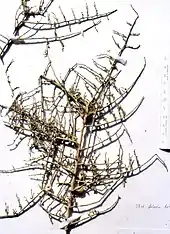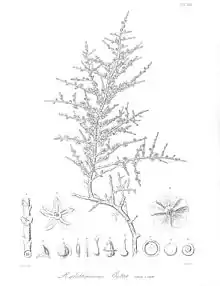| Halothamnus bottae | |
|---|---|
 | |
| Scientific classification | |
| Kingdom: | Plantae |
| Clade: | Tracheophytes |
| Clade: | Angiosperms |
| Clade: | Eudicots |
| Order: | Caryophyllales |
| Family: | Amaranthaceae |
| Genus: | Halothamnus |
| Species: | H. bottae |
| Binomial name | |
| Halothamnus bottae | |
| Synonyms[1] | |
| |
Halothamnus bottae is a species of the plant genus Halothamnus, that belongs to the subfamily Salsoloideae of the family Amaranthaceae. It occurs on the Arabian peninsula.[1]
Morphology
Halothamnus bottae is a shrub 30–50 cm high, with blueish-green, thorny branches. The leaves are standing off from the branches, they are triangular, and only 0,7-3 (rarely 8) mm long. The flowers are 2,6-3,6 mm long. The winged fruit is 6–9 mm in diameter. The bottom of the fruit tube has large ovate shallow pits alternating with five prominent radial veins (from the navel to the tepals).[1]
The subspecies H. bottae subsp. niger differs by green twigs soon becoming black, and by dark brown wings of fruit.[1]
 fruit (lateral view)
fruit (lateral view) fruits (bottom) of subsp. niger (left) and subsp. bottae (right)
fruits (bottom) of subsp. niger (left) and subsp. bottae (right)
Taxonomy

Halothamnus bottae has been first described in 1845 by Hippolyte François Jaubert and Édouard Spach (in Illustrationes plantarum orientalium, volume 2, pl. 136). It is the type species of the genus Halothamnus.[1]
It consists of two subspecies:[1]
- Halothamnus bottae subsp. bottae
- Halothamnus bottae subsp. niger Kothe-Heinr.
Distribution
Halothamnus bottae is endemic on the Arabian peninsula (Saudi Arabia, Yemen, Oman, United Arab Emirates). It grows in open shrubland and semidesert on dry stony ground, from 0–2000 m above sea level. The subspecies H. bottae subsp. niger occurs only on southern Arabian peninsula, in hot arid lowlands up to 100 m above sea level (similar plants from eastern Africa belong to Halothamnus somalensis).[2]
Uses
In Oman, the dried parts of Halothamnus bottae are used as snuff.[3]
Vernacular names
In Saudi Arabia, it is known as "hamḑ al-arnab" and "tiḩyan".[4] In Oman, Jibbali and Dhofari, commons names are "hamdeh" and "kizzot".[5] In Yemen, it is called "asal"[6] and "tanēt".[7]
References
- 1 2 3 4 5 6 Gabriele Kothe-Heinrich: Revision der Gattung Halothamnus (Chenopodiaceae). Bibliotheca Botanica Bd. 143, Schweizerbart, Stuttgart 1993, ISBN 978-3-510-48014-2, p. 53-57
- ↑ Gabriele Kothe-Heinrich: The genus Halothamnus (Chenopodiaceae) in Southwest Asia. - Flora et Vegetatio Mundi 9, 1991, p.43-52.
- ↑ Herbarium specimen Miller 6494 (Herbarium: E)
- ↑ J. P. Mandaville: Flora of eastern Saudi Arabia. - London/New York: Kegan Paul International, 1990.
- ↑ A. G. Miller & D. M. Morris: Plants of Dhofar. - Muscat: Office of the Adviser for Conservation of the Environment, 1988.
- ↑ Herbarium specimen Wissmann 852 (Herbarium: LE)
- ↑ E. Blatter: Flora Arabica 8,1. - Calcutta: Superintendent government printing, 1919.